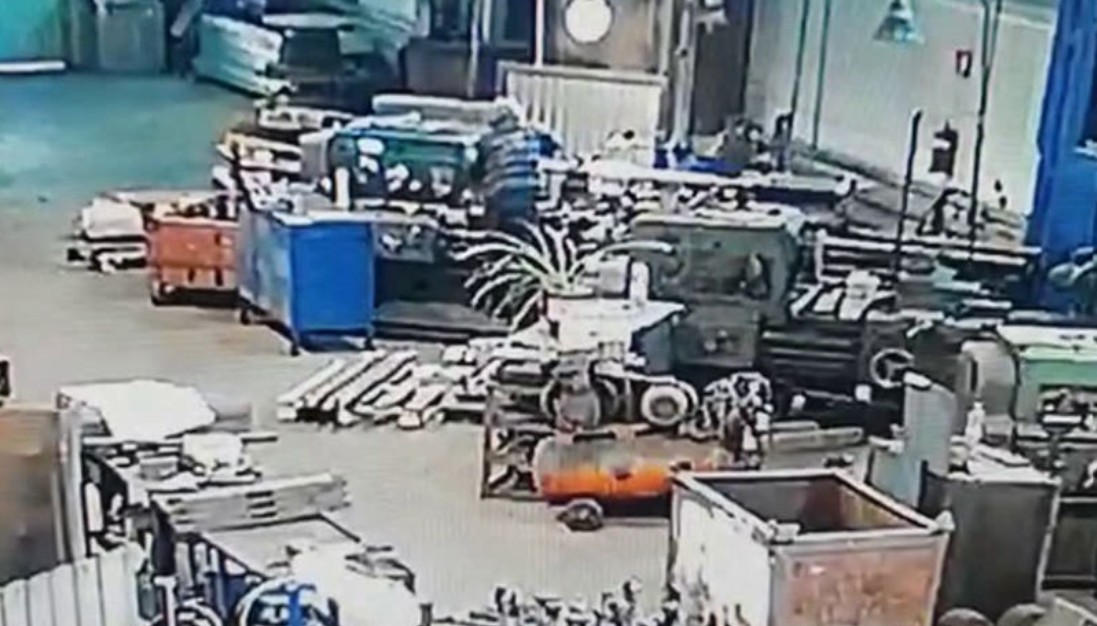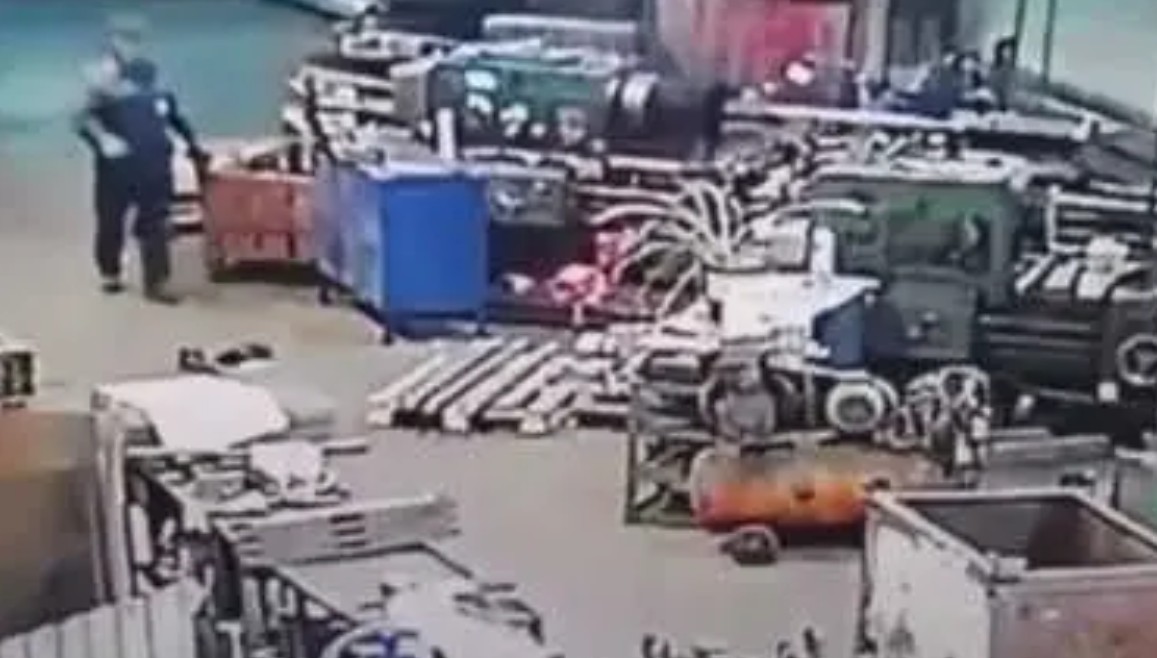Russian Lathe Accident Video and Workplace Safety
The Russian Lathe Accident is one of the most infamous viral gore videos of the 2020s. Captured on a factory security camera, the clip shows a man in Russia being pulled into a rotating lathe, resulting in his immediate and gruesome death. The video first surfaced in November 2020 and quickly spread online, circulating through shock-content websites, gore forums, and eventually mainstream platforms like Reddit.

Beyond its disturbing visuals, the Russian Lathe Accident became a symbol of two interconnected cultural phenomena: the dangers of industrial machinery and the internet’s fascination with extreme shock content. Over the years, it inspired memes, discussions, and cautionary posts reminding workers and internet users alike of the lethal risks of unsafe practices around heavy equipment.
Contents
Background of the Accident and Video
The accident reportedly took place in November 2020 in a Russian factory. The victim, an unidentified man working on a lathe machine, was drawn into the fast-spinning equipment. Lathes are powerful industrial machines used to shape metal or wood by rotating the material against a cutting tool. While essential in many industries, they are notoriously dangerous if mishandled or if safety protocols are ignored.
The uncensored video of the Russian Lathe accident has received deep condolences from everyone
russian-lathe-accident-video.mp4
In the video, the man appears to make contact with the machine while it is running. Within seconds, his body is caught and pulled into the rotation. The force of the spinning mechanism tears him apart, with body parts hurled across the factory floor. The aftermath, reportedly captured in accompanying photographs, shows pieces of the victim lodged in the machine itself.
The horror of the accident lies not only in the man’s death but also in the sheer violence of the machinery’s motion, making it one of the most shocking workplace tragedies ever caught on tape.
Initial Online Appearance
The video first appeared online on November 19th, 2020, when a user named KC uploaded it to the shock-content forum Documenting Reality. Known for hosting graphic and often disturbing content, the site was a natural first stop for the clip. The post included both the security camera footage and several still photographs allegedly taken after the accident.

The response on Documenting Reality was immediate. Some users expressed horror at the graphic nature of the footage, while others discussed the technical aspects of the machinery and the safety lapses that led to the tragedy. For many, the video served as a grim example of why industrial workplaces require strict adherence to safety measures.
Viral Spread Across the Internet
Although initially confined to gore communities, the Russian Lathe Accident quickly spread to broader internet platforms. Reddit played a central role in popularizing the clip and embedding it within internet culture.
Reddit Reposts
On December 16th, 2020, the video was reposted to the subreddit r/DarwinAwards. The Darwin Awards subreddit highlights examples of fatal mistakes and poor decisions that allegedly remove unsafe individuals from the gene pool. The post was titled, “Sticking your hand in a running machine isn’t the best idea.” This darkly humorous framing matched the subreddit’s tone, though it disturbed many who saw the graphic footage. Over four years, the post earned more than 4,400 upvotes, making it one of the most-discussed entries in that community.
On August 12th, 2021, the clip appeared again on r/watchthingsfly, a subreddit dedicated to videos of objects being violently thrown or propelled. Given the force of the lathe’s motion, the video fit the theme, though in a gruesome context. This post gained over 20,000 upvotes within three years, showing how shock content can cross over into communities not primarily dedicated to gore.
Other Online Communities
Beyond Reddit, the video circulated widely on gore-specific sites, Telegram groups, and niche forums. Its reputation grew to the point where even people who had never watched the video recognized references to “the Russian lathe accident.” On social media, memes began referencing the dangers of lathes, often jokingly reminding others not to “end up like the Russian lathe guy.”
Shock Content and Meme Culture
The Russian Lathe Accident quickly cemented its place in the history of shock videos. Like other infamous clips such as “1 Man 1 Jar” or the industrial shredder accident videos it became a grim cultural reference point.
Unlike fictional horror movies, real accident footage carries a weight that many find more disturbing. Yet, paradoxically, the video also became fodder for dark humor. Memes appeared with captions like “When you think you can beat the machine” or “Darwin Award 2020 goes to…”.
This dual reaction revulsion mixed with humor is common in shock culture. For some, it is a way of coping with the disturbing nature of the video. For others, it reflects internet communities’ tendency to push the boundaries of acceptable content.
Workplace Safety Concerns Highlighted
Beyond its viral spread, the Russian Lathe Accident underscores a serious issue: the dangers of industrial workplaces. Lathes, milling machines, and other heavy equipment are responsible for thousands of accidents worldwide every year. Common hazards include entanglement with clothing, loss of limbs, and, in extreme cases, death.
The accident illustrates several important lessons:
Proper Training: Workers must be thoroughly trained in machine operation before use.
Protective Measures: Safety guards and shields are essential to prevent contact with moving parts.
Awareness of Risk: Even a momentary lapse of judgment can result in irreversible consequences.
The viral nature of the video has inadvertently served as a cautionary tale. While many viewers watched out of morbid curiosity, some industrial safety advocates have used the clip as an example in training sessions, reminding workers that real-life accidents can be just as horrific as the video suggests.
Ethical Debate Around Sharing Gore Videos
The Russian Lathe Accident also raises questions about the ethics of sharing graphic content online. Why do people feel compelled to watch or repost such horrifying footage?
Morbid Curiosity
Human beings have long been drawn to spectacles of death and tragedy, from gladiator arenas to public executions. The internet simply provides a new medium for this age-old fascination.
Awareness vs. Exploitation
Some argue that sharing the video spreads awareness about workplace safety and the dangers of industrial machinery. Others counter that reposting such content exploits the victim’s death for entertainment.
Desensitization
Critics worry that repeated exposure to gore may desensitize viewers, dulling empathy and normalizing violence. The Russian Lathe Accident, with its shocking visuals, is often cited in discussions about this concern.
Ultimately, the debate reflects larger questions about the role of the internet in shaping human morality and the boundaries of free expression.
Legacy of the Russian Lathe Accident
Nearly five years after it first surfaced, the Russian Lathe Accident remains one of the most well-known viral gore videos. It continues to be referenced in meme culture, shock forums, and workplace safety discussions. For many, even hearing the phrase “lathe accident” immediately recalls this particular tragedy.
Its legacy is twofold:
As Internet Shock Content – It remains a notorious example of how quickly graphic videos can spread, becoming cultural touchstones in certain online communities.
As a Safety Reminder – Despite its grimness, the video reinforces the importance of respecting industrial machinery. For some, it stands as a permanent warning against unsafe practices.
The Russian Lathe Accident is both a horrifying tragedy and a viral internet phenomenon. First shared in November 2020, the video spread rapidly across shock forums and mainstream platforms, becoming a reference point in dark humor and meme culture. Its impact highlights not only the dangers of industrial machinery but also the internet’s complex relationship with gore, shock, and morality.
Ultimately, the Russian Lathe Accident endures because it sits at the crossroads of fear and fascination. It is a gruesome reminder that while machines enable human progress, they can also destroy lives in seconds if treated without caution. For all its notoriety online, perhaps the most important lesson is this: the viral video is not just entertainment it is a real human tragedy that underscores why workplace safety must always be taken seriously.
Daily News -Tijana Radonjic Parasailing Fall Full Video Footage
Colombian Presidential Candidate Shot Video and Global Reaction
Kaitlyn Flynn Oilers Original Video Leaves Fans in Awe
Arturo Gamboa Video Sparks Chaos at Utah Rally
Anonymous False Flag Video Points to Mysterious Plot
Scott Rogers Video and Online Privacy Concerns
Adrian Peterson Poker Fight Video Goes Viral on Social Media

